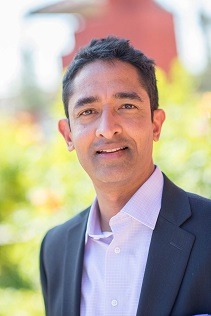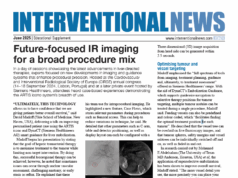
In February, Philips announced the global launch of Azurion, its next generation image-guided therapy platform, which forms the new core of its integrated solutions portfolio. Atul Gupta, chief medical officer for Philips’ Image Guided Therapy business has spent more than 15 years as a practicing interventional radiologist. He guides Interventional News through the key features of the new platform.
The Azurion image-guided therapy platform is the result of a multi-year development programme conducted in close collaboration with leading clinicians in the field. It features a state-ofthe-art ergonomic design with an easy-to-use intuitive user interface, enabling clinicians to swiftly and confidently perform a wide range of routine and complex procedures in the interventional lab, a media release from Philips says. With the rapid growth of image-guided therapy procedures, hospitals and health systems are increasingly faced with the need to control costs, while improving their standards of care. Azurion has been designed to address these challenges and is equipped with new workflow options and performance dashboards, as well as an upcoming range of productivity improvement services.
New components, high image quality at ultra-low X-ray dose and real-time image processing on multiple work spots within the interventional lab. From the standpoint of an interventional radiologist, what are the key benefits that Azurion will offer?
Most importantly, it is vital to have superior performance—that is the bottom line. By superior performance, I mean that Azurion offers superb image quality alongside ultra-low dose radiation—that is the heart of the system and it has over 1,000 new components built in to achieve this. If you think about the procedures that we are doing today, they are completely different from those we did 10 or 15 years ago. A decade or so ago, I basically had X-rays to see the device and the patient and that was it. Now, my procedures are far more complex and diverse, so I need to integrate a whole host of 2D and 3D imagery and data together to navigate the procedure.

Azurion allows us to connect all of these different information sources into the system. Personally, just like a pilot in a cockpit, I want to have total access to all the information I need at my fingertips. And not just to view it, but also to interact with it. Azurion lets me interact and control things like electronic health records, PACS, ultrasound, haemodynamic monitors, 3D workstations, and so on, all from my table side. So there is the superior performance, there is the interaction and connectivity of the multiple devices, and then, there is the efficiency. One of the ways that Azurion can increase efficiency by its touchscreen capabilities. This is a very intuitive and elegant interface with simple gestures that you and I are already familiar with from our smartphones and tablets, such as zooming in or pinching to collimate the image. The world of intervention has become so complex that systems need to blend into the background. You could have the best tools in the world, but if they are overly complicated, nobody will end up using them. Ultimately we know that these tools improve outcomes, reduce radiation, reduce procedure time, so we want people to use these tools. The only way to get them to use the tools is to make a simple elegant user interface. We just want to be physicians; we are not computer programmers, so these systems really need to feel like extensions of our hands and our minds. We do not want to have to think about how to programme the system, we just want to keep our minds and our eyes on the patient.
All interventionists are now expected to do “more with less”. How will Azurion help achieve this?
Today, we are expected to do many more cases than we were doing 10 years ago. Patients are getting sicker and minimally invasive treatments are markedly expanding. Azurion allows me to do more cases, potentially, per day and also more diverse types of cases. This is especially true if you are sharing the lab with cardiology colleagues or vascular surgery colleagues. In such a scenario, suites need to be capable of doing everything from structural heart disease repairs to aneurysm repairs to interventional oncology procedures.
Today, to get more cases a day completed means that I have less time per case. And I also want to do more cases with less radiation exposure. To be entirely truthful, I also have fewer staff. With hospitals crunching costs, sometimes I may have only one tech – nologist available to me on call, and I need that one technologist to be able to do everything. So how does Azurion solve all of these things? Well, by increasing efficiency in the lab, Azurion allows me to do procedures in less time. We actually did some usability testing with over 60 users. These were not just physicians but also technologists throughout North America and Europe. Over 90% felt that Azurion would allow them to become more efficient in the lab.
So if I can shave of five or 10 minutes a case over the course of a busy day, this could add up to maybe an extra case per day. At the same time, I can also use dose reduction tech – nology and new positioning features built into the system to significantly reduce radiation dose for patients and staff. Azurion allows the technologist to control every aspect of this system from the table side via touchscreen. I think all interventionists have been in the situation where they have technologists who have to take off their gloves to go into a control room, or somewhere else, to operate a piece of equipment before coming back and scrubbing in again, and this process goes on, back and forth, during an acute intervention, simply because you are short on staff. That is now gone because you can now control Azurion and these connected devices, all while scrubbed and directly from the tableside. I think these are just a few ways that Azurion addresses doing more with less.
Who were the thought leaders in interventional radiology who collaborated and contributed to Azurion’s development?
A few of our interventional radiology collaborators for Azurion have been Barry T Katzen, founder and chief medical executive of the Miami Cardiac and Vascular Institute, Baptist Health South Florida (Miami, USA; See Katzen’s article on critical limb ischaemia treatments on page 35); Marco van Strijen, St Antonius Hospital (Nieuwegein, the Netherlands); Ralf-Thorsten Hoffmann chief of Interventional Radiology, Dresden University Hospital (Dresden, Germany); and Otto Elgersma, Albert Schweitzer Hospital (Dordrecht, the Netherlands). Cardiologists, surgeons, technologists and administrators also collaborated with us from 20 sites around the globe.
Azurion is the result of a long development programme and collaboration with leading clinicians in the field. You cannot create these technologies in a vacuum and then put them out there and expect them to be used. We firmly believe that collaboration leads to the best innovation.













